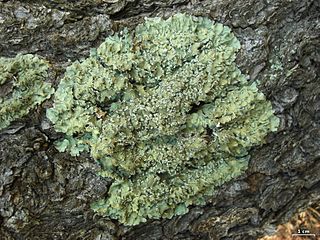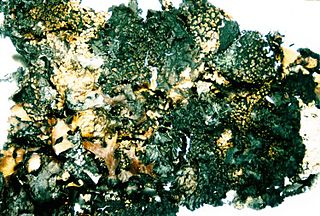
The Parmeliaceae is a large and diverse family of Lecanoromycetes. With over 2700 species in 71 genera, it is the largest family of lichen-forming fungi. The most speciose genera in the family are the well-known groups: Xanthoparmelia, Usnea, Parmotrema, and Hypotrachyna.

Allocetraria is a genus of lichenized fungi in the family Parmeliaceae. It consists of 12 species, with a center of distribution in China.

Arctocetraria is a genus of foliose lichens in the family Parmeliaceae. It has three species.
Cetreliopsis is a genus of four species of lichens in the family Parmeliaceae.

Flavocetraria is a genus of lichenized ascomycete fungi in the family Parmeliaceae. The genus contains two species found in arctic-alpine and boreal regions, Flavocetraria cucullata and F. nivalis.

Kaernefeltia is a genus of lichenized fungi in the family Parmeliaceae.

Masonhalea is a genus of two species of lichenized fungi in the family Parmeliaceae.

Melanelia is a genus of lichenized fungi in the family Parmeliaceae. The genus was circumscribed by Ted Esslinger in 1978.

Flavopunctelia is a genus of foliose lichens in the family Parmeliaceae. The genus contains species that are widespread in temperate and tropical areas. The genus is characterised by broad, yellow-green lobes, point-like (punctiform) pseudocyphellae on the thallus surface, and bifusiform conidia. All species contain usnic acid as a major secondary chemical in the cortex. Flavopunctelia was originally conceived as a subgenus of Punctelia by Hildur Krog in 1982; Mason Hale promoted it to generic status in 1984.

Canoparmelia is a genus of lichen-forming fungi in the family Parmeliaceae. The widespread genus contains about 35 species. Canoparmelia, a segregate of the parmelioid lichen genus Pseudoparmelia, was circumscribed by John Elix and Mason Hale in 1986.

Bulbothrix is a genus of lichen-forming fungi in the family Parmeliaceae. This genus is synonymous with Bulbothricella V.Marcano, S.Mohali & A.Morales. Bulbothrix was circumscribed by lichenologist Mason E. Hale in 1974 with Bulbothrix semilunata as the type species.

Parmotrema is a genus of lichen belonging to the family Parmeliaceae. It is a large genus, containing an estimated 300 species, with a centre of diversity in subtropical regions of South America and the Pacific Islands.

Punctelia is a genus of foliose lichens belonging to the large family Parmeliaceae. The genus, which contains about 50 species, was segregated from genus Parmelia in 1982. Characteristics that define Punctelia include the presence of hook-like to thread-like conidia, simple rhizines, and point-like pseudocyphellae. It is this last feature that is alluded to in the vernacular names speckled shield lichens or speckleback lichens.
Cetrariopsis is a genus of foliose lichens in the large family Parmeliaceae. The genus contains three species, including the type, Cetrariopsis wallichiana.

Tuckermanella is a genus of lichen-forming fungi in the family Parmeliaceae.

Asahinea is a genus of lichenized fungi in the family Parmeliaceae. The genus has a widespread circumpolar distribution, and contains three species. The genus was circumscribed by the husband and wife lichenologist team William and Chicita F. Culberson in 1965, with Asahinea chrysantha as the type species. The genus name honours Japanese lichenologist Yasuhiko Asahina.
Bryocaulon is a genus of lichenized fungi in the family Parmeliaceae. The genus has a widespread distribution in north temperate regions, and contains three species. The genus was circumscribed by Swedish lichenologist Ingvar Kärnefelt in 1986.
Himantormia is a genus of lichenized fungi in the family Parmeliaceae. The genus, which contains two species, is found in Antarctica. The genus was circumscribed by British lichenologist Elke Mackenzie in 1964.
Davidgallowaya is a genus of lichenized fungi in the family Parmeliaceae. The genus is monotypic, containing the single corticolous species Davidgallowaya cornutispora, found in Papua New Guinea. Davidgallowaya was circumscribed by Dutch lichenologist André Aptroot in 2007. The genus name honours David Galloway (1942–2014).
Raesaenenia is a fungal genus in the large family Parmeliaceae. It is a monotypic genus, containing the single lichenicolous fungus Raesaenenia huuskonenii, which parasitises lichens of genus Bryoria in the Northern Hemisphere.













